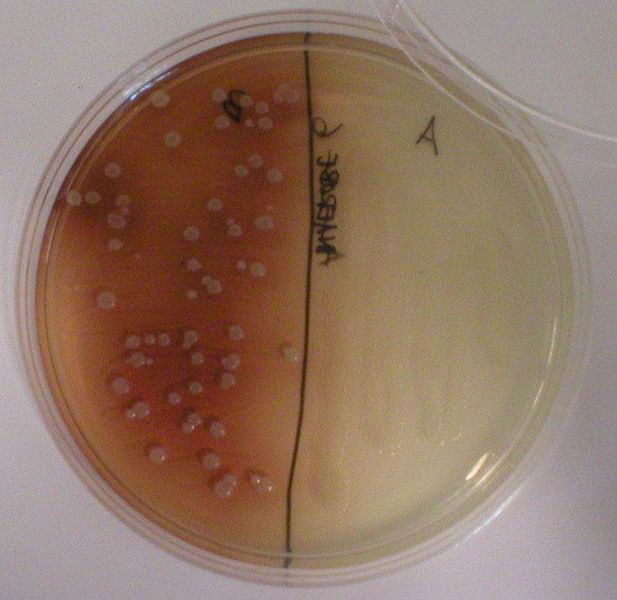Aeromonas salmonicida
A Microbial Biorealm page on the genus Aeromonas salmonicida
Classification
Higher order taxa
Bacteria; Proteobacteria; Gammaproteobacteria; Aeromonadales; Aeromonadaceae; Aeromonas
Genus species
Aeromonas salmonicida
Description and significance
Aeromonas salmonicida is a gram-negative bacillus that is critical to both wild and cultivated fish, especially salmon,because it is the causative agent of the disease furunculosis . Most strains of the bacterium are non-motile. A. salmonicida is a facultative aerobe, preferring to obtain energy through the utilization of oxygen as a terminal electron acceptor.The bacterium’s optimal growth temperature is between 22 and 25°C. The maximum temperature that it can grow at is 34.5°C. After about a 24 hour growth period the colonies are about the size of a pin point. The colonies also have a brown pigmented color that appears after it has been growing for 48-72 hours. It is negative for the indole formation test, Voges-Proskauer test, citrate utilization test, coagulase test, starch hydrolysis, casein hydrolysis, triglyceride hydrolysis, phospholipid hydrolysis, hydrogen sulfide production, citrate utilization, and the phenylalanine test. It is positive for the oxidase test, lysine decarboxlase test, methyl red test, gelatin hydrolysis test, and catalase test.

Plate provided by J. Cox, A. Beuler, G. Cervenka and K. Grospe and image taken by M. Glogowski
Genome structure
Cell structure and metabolism
Aeromonas salmonicida is bacillus in shape. The short rods have rounded ends which allow it to be easily confused as a coccus. The colony size of Aeromonas salmonicida is between 1-2nm. Aeromonas salmonicida is a facultative anaerobic which means that it is capable of making ATP by aerobic respiration if oxygen is present but is also capable of switching to fermentation when oxygen is not present. It does not have fermentation of sucrose or lactose but it does of glucose. The glucose fermentation also created gas.
Quorum sensing
In response to an increase in bacterial population, Aeromonas salmonicida uses quorum sensing to control gene expression. Quorum sensing is controlled through the release of a molecule called AHL, which is an N-linked acyl chain of either four or six carbons. As a result of quorum sensing, A. salmonicida produces and releases serine protease. The release of serine protease also makes this bacterial species virulent. There are twenty-five strains of A. salmonicida; three of the strains contain R factors that make the bacteria drug resistant. NCMB833, one of the three strains, is resistant to tetracycline and sulfathiazole, while Ar-32 and Ar-33 are resistant to sulfathiazole, chloramphenicol, and streptomycin.
Pathology
Aeromonas salmonicida is the bacterium that causes the disease furunculosis in marine and freshwater fish. Furunculosis is characterized by the appearance of large boils on the side of the fish. The symptoms the fish show are external and internal hemorrhaging, swelling of the vents and kidneys, boils, ulcers, liquefaction, and gastroenteritis. Furunculosis is commonly known as tail rot in fish and is common in gold and koi fish. Infected fish with open sores are able to spread the disease to other fish. Due to the high density of fish in aquaculture, this disease can spread rapidly, and with devastating results. The development of a vaccine has reduced the incidence of furunculosis outbreak, however the occasional outbreak is still seen.
References
Bergey,David Hendricks,.Bergey's Manual of Systematic Bacteriology. Vol. 2, The Proteobacteria. Part B,The Gammaproteobacteria.Williams & Wilkins, 1984.
AFFA (2001). Disease Strategy: Furunculosis. In: Australian Aquatic Veterinary Emergency Plan (AQUAVETPLAN), Agriculture, Fisheries and Forestry - Australia, Canberra, ACT. 72 pp.
Michael E Reith, R K Singh, B Curtis, J M Boyd , A Bouevitch, J Kimball , J Munholland, C Murphy, D Sarty, J Williams, J HE Nash, S C Johnson1, and L L Brown. "The genome of Aeromonas salmonicida subsp. salmonicida A449: insights into the evolution of a fish pathogen". BMC Genomics 2008. Volume 9. p. 427.
Chhabra, S., Durant, E., Fish, L., Karlyshev, A., Macintyre, S., Stewart, G., Swift, S., Williams, P., and Winson, M. “Quorum Sensing in Aeromonas hydrophila and Aeromonas salmonicida.” Journal of Bacteriology, 1997. Volume 177. pp. 5271-5281.
Egusa, S., Kimura, T., Takashi, A., and Watanabe, T. “Detection of R Factors in Naturally Occurring Aeromonas salmonicida Strains.” Applied Microbiology, 1971. Volume 22. pp. 716-717.
AFS-FHS (American Fisheries Society-Fish Health Section). "3.2 Aeromonas salmonicida (Furunculosis". FHS blue book: suggested procedures for the detection and identification of certain finfish and shellfish pathogens.2007 edition. AFS-FHS, Bethesda, Maryland.
Created by students of M Glogowski
